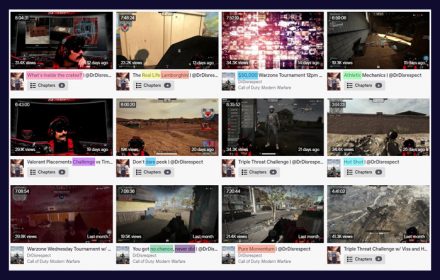Streaming gives content creators a unique opportunity. Being able to reach a live audience all around the world at any time during the day.
But choosing the right time to stream has a huge impact on the amount of viewers you can reach with your broadcasts.
We’ll break down the facts to help you decide the best time to stream on twitch for you.
What is the peak time for Twitch? Let’s look at the data.
If location is key for businesses, then timing is key for streamers. It makes sense to try and schedule your streams for when you have the chance to get the most viewers.
There are two things to keep in mind when looking into peak Twitch time stats.
- What is the peak viewer times?
- How does peak viewer times relate to how many streamers are broadcasting?
Let’s dive into the data. We might be able to find pockets of time where viewer counts are much higher than the amount of streamers. (Hint: there is)
Peak Viewer Time For Twitch
According to Twitchtracker, the lowest viewer time is around 3:00 a.m. EST. (They are using GMT time so it shows as 5 hours ahead)
![]()
This steadily increases until about 1:00 p.m. EST where it holds until 3:00 p.m. EST. From there it begins to decline for 12 hours until 3:00 a.m. EST.
The same trend appears on every popular stat site like Sullygnome, Twitchtools, and Twitchapps.
The reason you’re seeing this trend is that it starts with the U.S. night-owls and morning European crowd. As the Euro crowd moves into the afternoon, the U.S. morning crowd is tuning in. This starts the push of viewers towards the peak time. It tops out as U.S. gets closer to peak viewing time while European viewers are in evening hours.
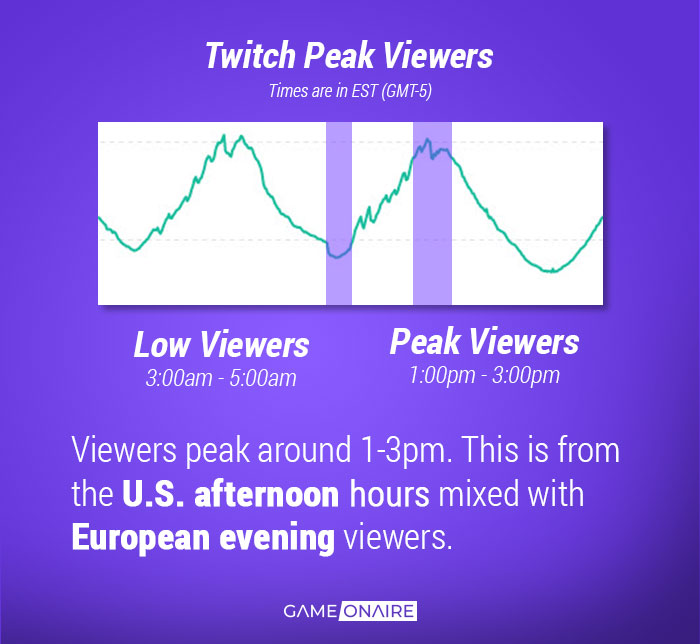
Peak Streamer Time For Twitch
It’s one thing to know when all the viewers are there. But how many streamers are vying for that attention?
If we overlay the streamer count to the total viewers, we start to see something interesting.
![]()
At first glance it looks like it’s pretty similar. As the view count starts to soar, so does the amount of streamers.
But if you look closely, you start to see something very interesting.

The viewer count rises quicker than the streamer count!
Streaming in the morning gives you a larger potential viewer base, without as many streamers to compete with.
After it peaks, the streamer count holds steady while the viewer count drops. Meaning those streamers are all fighting for less viewers.
Which results in viewer ratios like the graph from Sullygnome:
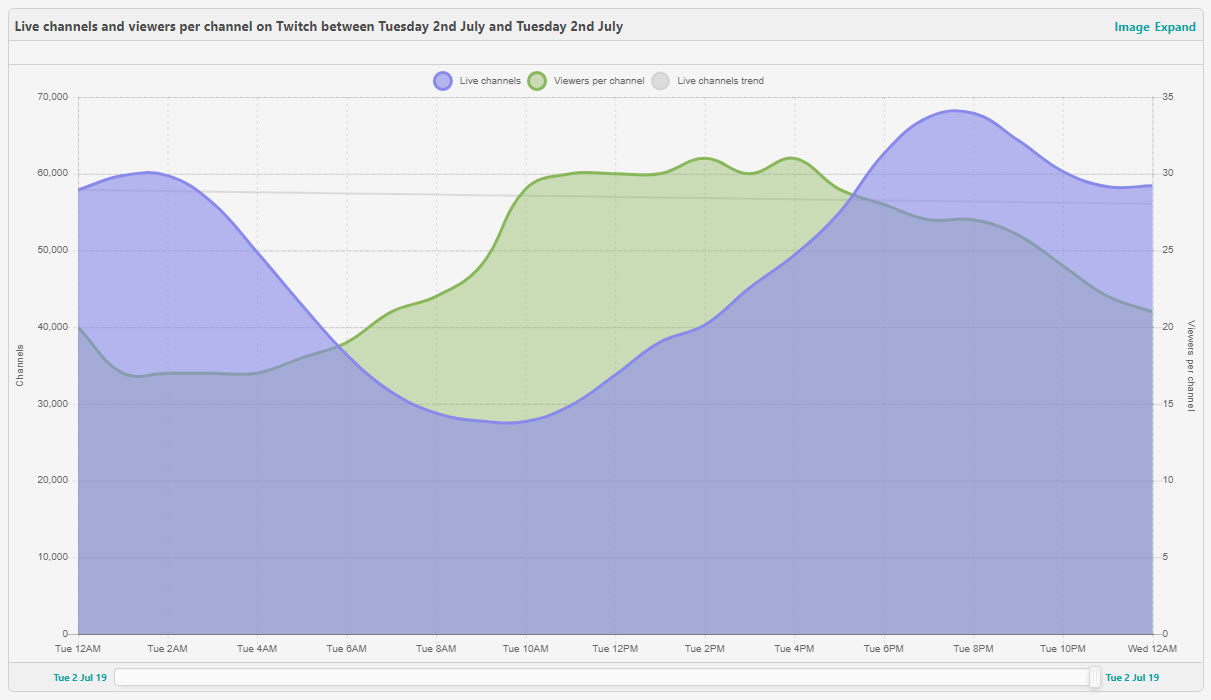
The green represents is viewers per channel, the higher it is, in theory, the easier it is to get viewers.
The blue represents live channels. The lower that is compared to the green reveals the pockets of time where it’s most advantageous to stream.
This is the big picture view though. We’re talking hundreds of thousands of viewers. This represents the idea that you CAN reach more viewers during these time slots. But it’s not the only factor. Factors like:
- The language of the audience you stream to
- The game(s) you want to stream
- Or even what other streamers are doing
These can all influence the ease or difficulty of getting new viewers.
Let’s take a look at these factors individually.
What Are Other Streamers Doing?
Take a look at what other streamers are doing for the games you stream. You want to zig while everyone else is trying to zag.
Are there any celeb-like streamers that always attract viewers?
For a long time Kripparian dominated the late night Hearthstone space. When his stream started up, Hearthstone streamers would see their numbers plummet. (You’d even see people spamming chat that they were leaving because Kripp went live). These streamers absorb a lot of the viewers no matter what you do.
In this situation you can try to schedule your stream near the end of their stream. Those viewers need somewhere to go once the stream is over. You also have the chance to get a lucky host from the big streamer at the end of their stream.
Or you can plan your stream to end right after theirs starts. Giving you the ability to host them and get your foot in the door for networking with them.
This doesn’t mean you shouldn’t stream while other big streamers are live. Because as an added benefit of having a big streamer in your game category, it pushes the game up higher in the directory.
The higher it is in the directory the more chance you have of new viewers checking it out from the browse tab. This attention can spread to your channel if there aren’t many streamers. Or if you’re able to hold one of the top 4-6 spots of your games listings. But, in most cases, it’s usually advantageous to stream before or after the big streamer.
How does the streamer to viewer ratio change throughout the day?
There are usually pockets of time that you can find that have less streams making it easier to pick up viewers.
You can use a tool like Twitchstrike to find these times easier. Enter in the game(s) you play and scroll down to the heat map section. I prefer to look at the “Ratio Heat Map” on the left. The darker purple squares are blocks of time where the ratio of viewers to streamers is the highest.
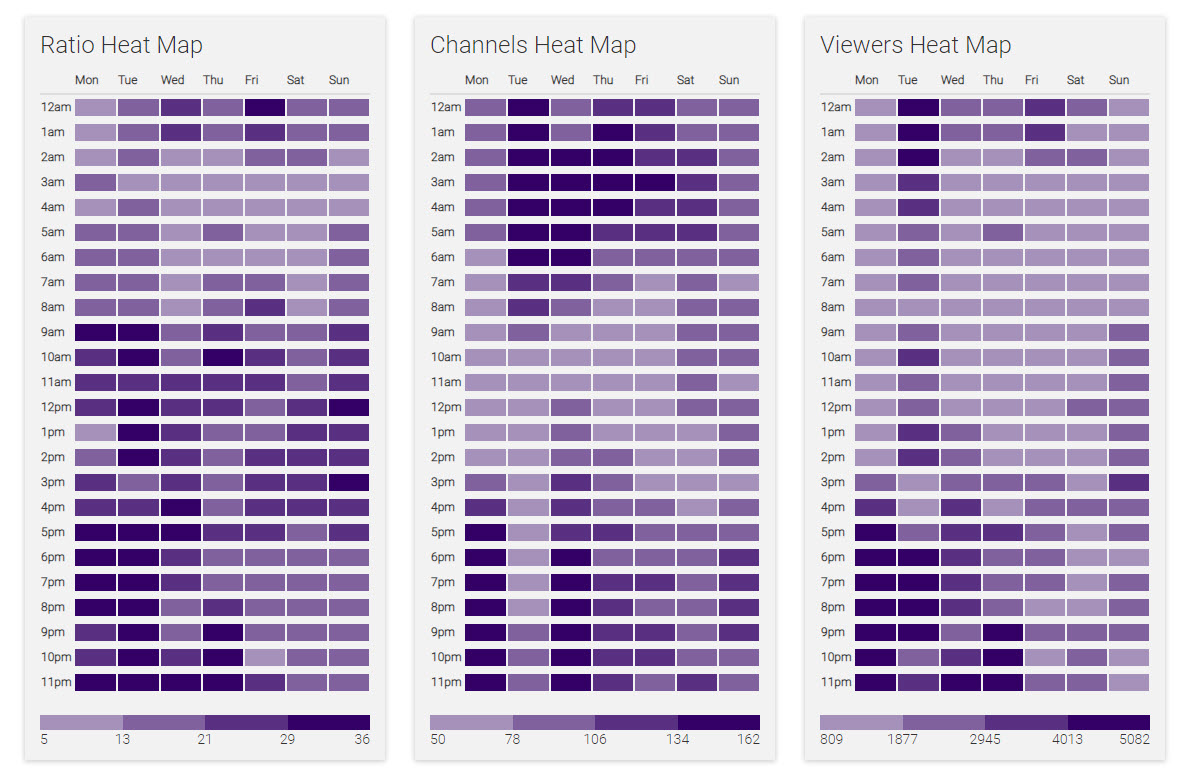
This saves you the work of checking your game category manually throughout the day. You can come here and see the averages for the last 7 or 28 days.
Consider peak times for the game(s) you play
Different games have different peak hours. To figure this out you can use Twitchstrike like mentioned above. But it’s also a good idea to think about the audience you’re trying to stream to. Some games have younger or older audiences. Other games are more popular in different countries. Take this into consideration when forming your schedule.
Fortnite, Roblox, and Minecraft generally have a younger audience watching. That means viewers peak in the summertime. Also school hours or bed times can influence off-peak hours.
On the other hand, games like Magic: The Gathering, Dungeons & Dragons, and Escape From Tarkov tend to draw in a much older crowd. Work hours can affect this time, but also this crowd usually stays up later.
What schedule works best for you?
Having a consistent schedule is a crucial to building a following for your stream. It’s better to have a lighter schedule that you know you can stick to.
You want your viewers to get into the habit of tuning into your streams. You want them to just know your live.
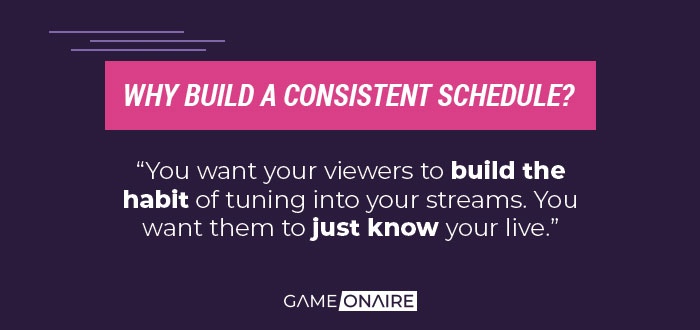
A mistake a lot of streamers make is to set an ambitious schedule that they don’t follow through with. This makes it difficult for viewers to know if and when you’re live.
Don’t worry!
If you have extra time and want to stream extra you can frame it as a “bonus stream”. You come off as the hero giving back more to your audience. Your audience begins to instinctively learn and rely on your main schedule. It’s a win/win.
Being able to perform and bring energy to your stream is equally important. Finding the right time slots that fit your energy levels, mood, or give you a solid work/life balance affect the results you get on stream. If you can’t entertain the potential audience at a certain time slot, it doesn’t matter how many viewers show up. They won’t stick around if you don’t entertain them.
Network opportunities
The connections you have can help boost the quality of your content and impact your viewership. Often times, these can help you grow quicker than streaming in the most “optimal” time slot.
Do you have friends that stream? Are you apart of any streaming communities? Or do have you built relationships with streamers who are active during a specific time slot? If so, these advantages can put you in a better position than venturing into unknown territory with no connections.
Sure, you can build these same connections. But having them built, or being apart of a community is a huge head start. They could make it worth streaming during less optimal times.
The Best Time To Stream?
Picking the right time to stream will make a huge difference in the potential viewers you can reach. The answer for best time will be different for everyone though.
Use the data here and form a plan to reach the maximum potential audience. Consider the game(s) you stream, the audience you want to reach, your resources, and your available time.
Put some serious thought into how you want to schedule your streams. Remember that consistency is extremely important. Once you set your schedule stick to it like it’s life or death for at least 30 days (the longer the better!). And after that adjust slowly if you see different opportunities.

